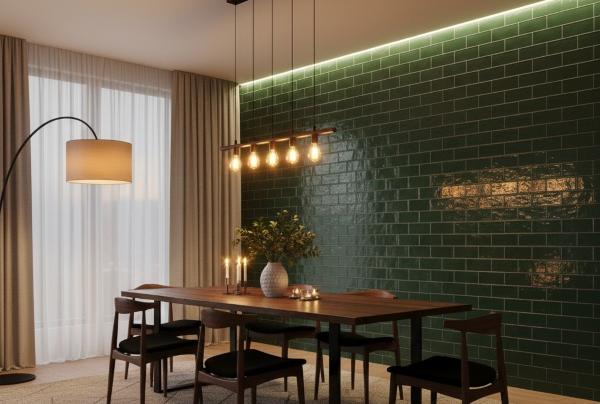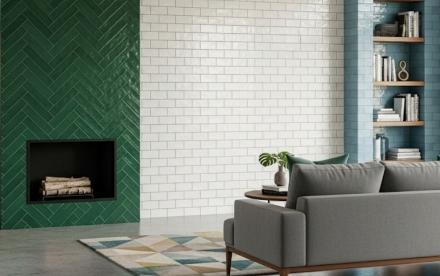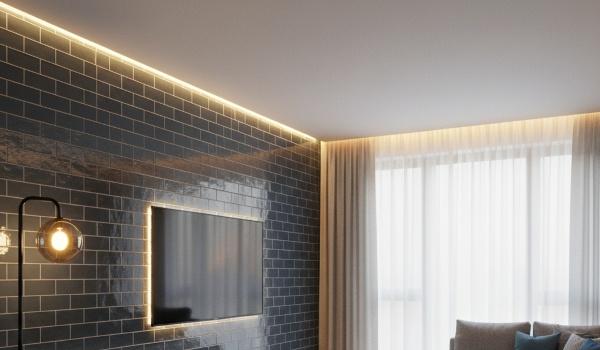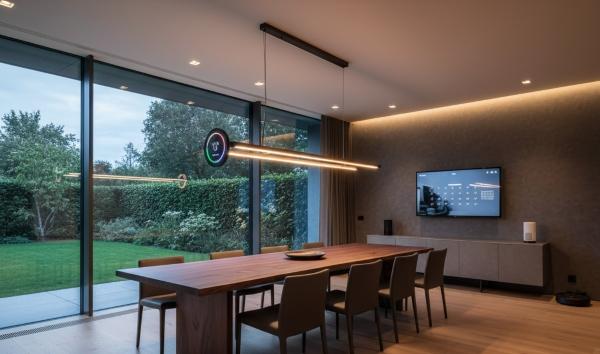Subway tiles paired with the right lighting can completely transform any space from ordinary to extraordinary. The classic 3x6 inch rectangular ceramic tiles, originally used in New York City subway stations, offer incredible versatility when combined with strategic lighting solutions. Whether you're renovating a kitchen backsplash, bathroom walls, or creating an accent wall, understanding how different lighting techniques interact with subway tile finishes, colors, and installation patterns is essential for achieving maximum visual impact and creating the perfect ambiance for your home.
Understanding the Foundation: Subway Tiles and Light Interaction
Subway tiles have maintained their popularity for over a century because of their timeless appeal and remarkable ability to work with various design styles. The clean, rectangular shape creates a perfect canvas that responds beautifully to different lighting approaches. When you're selecting from shop tiles by size, it's crucial to consider how light will interact with your chosen dimensions.
The surface texture of your subway tiles plays a significant role in how they reflect and absorb light. Glossy finishes create brilliant reflections that can make spaces appear larger and brighter, while matte finishes offer a more subdued, sophisticated look that works exceptionally well with warm lighting. Understanding these characteristics helps you make informed decisions when browsing shop tiles by style.
Color Temperature and Subway Tile Combinations
The relationship between color temperature and subway tile selection cannot be overstated. Cool white subway tiles paired with warm lighting (2700K-3000K) create a cozy, inviting atmosphere perfect for residential kitchens and bathrooms. This combination softens the stark white appearance and adds warmth to what could otherwise feel clinical.
Conversely, warmer colored subway tiles benefit from cooler lighting temperatures (4000K-5000K) to maintain color accuracy and prevent the space from feeling overly yellow or orange. When exploring shop tiles by color, consider how your lighting choices will affect the final appearance throughout different times of day.
Neutral gray subway tiles offer the most flexibility with lighting temperatures. They can handle both warm and cool lighting effectively, making them an excellent choice for spaces where you might want to adjust the ambiance seasonally or for different occasions.
Strategic Lighting Placement for Subway Tile Walls
Under-cabinet lighting represents one of the most effective ways to showcase subway tile backsplashes. LED strip lights installed beneath upper cabinets create even illumination across the tile surface, eliminating shadows and highlighting the grout lines that define the classic subway tile aesthetic. This approach works particularly well with different types of tiles and installation patterns.
Pendant lighting can create dramatic focal points when positioned strategically near subway tile installations. The key lies in selecting fixtures that complement rather than compete with the tile pattern. Simple, geometric pendant lights work exceptionally well, as they echo the clean lines of subway tiles without overwhelming the space.
Recessed lighting provides excellent general illumination for larger subway tile installations. When planning recessed light placement, ensure even distribution to avoid creating dark spots or harsh shadows that can make the tile pattern appear uneven or disjointed.
Installation Patterns That Maximize Lighting Effects
The traditional running bond pattern remains the most popular choice for subway tiles, but your lighting strategy can enhance alternative layouts for unique visual effects. Herringbone patterns create dynamic shadow play when lit from multiple angles, adding texture and movement to otherwise flat surfaces.
Vertical stack patterns work exceptionally well with linear lighting elements. Consider incorporating LED strip lights between tile sections or using track lighting that follows the vertical lines created by this installation method. This approach can make rooms appear taller while creating striking visual interest.
The basket weave pattern benefits from ambient lighting rather than directional lighting, as the complex pattern can become overwhelming when shadows emphasize every intersection. Soft, diffused lighting allows the pattern to be appreciated without becoming visually chaotic.
Grout Selection and Its Impact on Lighting Design
The interplay between grout selection and lighting dramatically shapes the visual impact of subway tile installations. When you choose lighter grout tones, they act as a reflective agent, bouncing light throughout the space and creating an expansive, airy atmosphere. This technique proves especially valuable in compact kitchens or bathrooms where every bit of reflected light counts toward opening up the room.
Opting for darker grout delivers bold definition, transforming each tile into a distinct element within a striking geometric grid. This high-contrast approach pairs exceptionally well with targeted lighting that emphasizes the rhythmic pattern of the grout lines. For polished transitions where your lighting elements meet the tile work, bullnose edges offer an elegant solution that maintains visual continuity.
Grout line thickness plays an equally important role in determining lighting outcomes. Narrow grout lines produce a nearly continuous surface that responds uniformly to ambient lighting, while generous grout spacing creates pronounced shadow play and depth that strategic spotlighting can amplify for dramatic effect.
Specific Room Applications and Lighting Strategies
Kitchen Applications
Subway tiles in the kitchen deliver on both style and practicality. A well-planned mix of functional and mood lighting transforms the space into an ideal hub for meal prep and gatherings. LED strips mounted beneath cabinets illuminate work surfaces while highlighting the texture and pattern of your backsplash.
For a striking visual effect, install lighting along the base of cabinets and islands—especially where tiles meet the floor. This creates an illusion of weightlessness, making cabinetry appear to float while adding architectural interest to your Nova Tile and Stone surfaces.
When hanging pendants above islands or dining counters, placement is key. Position them to prevent shadow patterns on your tiled walls, ensuring consistent light distribution that reveals the full beauty of your tilework without compromising visibility for cooking and dining activities.
Bathroom Considerations
Bathroom lighting for subway tiles requires careful planning around humidity and the dual need for practical and atmospheric illumination. Position fixtures around the vanity to flood tiled walls with even light, eliminating harsh shadows while ensuring clear visibility for daily routines.
In shower spaces featuring subway tiles, opt for moisture-resistant LED strips or wet-rated recessed lights. The aim is striking a balance-enough brightness to showcase the tilework's detail without sacrificing safety or function. Remember to consider how your floor materials interact with wall tiles as lighting shifts throughout the day.
The mirror zone offers creative opportunities for enhancing subway tile displays. Illuminated mirrors with built-in LEDs or backlit designs cast intriguing reflections onto surrounding tiled surfaces, amplifying the visual drama of your installation. This interplay between light and reflection can transform a simple tile pattern into a dynamic focal point.
Living Spaces and Accent Walls
Subway tiles aren't limited to kitchens and bathrooms. When used as accent walls in living spaces, they can create striking focal points with the right lighting approach. Track lighting or adjustable spotlights allow you to highlight specific sections of your subway tile installation while creating dramatic shadow patterns.
Fireplace surrounds featuring subway tiles benefit from both the natural light created by the fire and strategic accent lighting. Consider incorporating LED strips behind floating mantels or within recessed areas to create a warm glow that complements the fireplace when not in use.
Technical Considerations for LED Integration
Modern LED technology offers unprecedented opportunities for integrating lighting with subway tile installations. Color-changing LED strips can transform the appearance of white subway tiles throughout the day, allowing you to adjust the ambiance from cool and energizing in the morning to warm and relaxing in the evening.
Dimming capabilities are essential for maximizing the versatility of your subway tile and lighting combination. Install dimmer switches for all lighting elements affecting your tile installation to allow for fine-tuning based on time of day, activities, and personal preferences.
Smart lighting systems can be programmed to enhance your subway tile installation automatically. Set schedules that adjust color temperature and brightness levels to complement your tiles' appearance throughout daily routines and seasonal changes.
Maintenance and Long-term Considerations
The combination of subway tiles and lighting requires ongoing maintenance to preserve optimal appearance. Regular cleaning of both tiles and lighting fixtures ensures maximum light reflection and prevents dulling of the overall effect. Consider how easy cleaning methods for porcelain tiles apply to your specific installation.
LED fixtures generally require less maintenance than traditional lighting options, but they should still be cleaned regularly to prevent dust buildup that can reduce light output. This is particularly important for under-cabinet lighting where cooking residue can accumulate on fixtures.
Plan for eventual LED replacement by choosing fixtures with easily accessible drivers and replaceable components. While LEDs last much longer than traditional bulbs, having a maintenance plan ensures your subway tile installation always looks its best.
Budget-Friendly Lighting Solutions
Creating stunning subway tile and lighting combinations doesn't require expensive fixtures. Battery-powered LED strip lights offer an affordable way to experiment with accent lighting before committing to permanent installations. These can be particularly useful for testing different placement options and color temperatures.
Solar-powered outdoor LED fixtures can provide cost-effective lighting for outdoor tile applications where running electrical connections might be challenging or expensive.
DIY installation of basic LED strip lighting can significantly reduce project costs while still achieving professional-looking results. Many products we carry are designed with DIY installation in mind, making it easier to coordinate tile and lighting projects.
Design Trends and Future Considerations
Current design trends favor integrated lighting solutions that appear built into subway tile installations rather than added as afterthoughts. This approach creates cleaner lines and more sophisticated appearances that enhance the timeless appeal of subway tiles.
Minimalist lighting approaches are gaining popularity, with designers focusing on fewer, more strategic light sources rather than multiple competing elements. This trend works particularly well with the clean, simple lines characteristic of subway tile installations.
Sustainable lighting options continue to evolve, with solar-powered and energy-efficient solutions becoming more viable for residential applications. Consider how these technologies might integrate with your subway tile project for long-term environmental and cost benefits.
Professional Installation vs. DIY Approaches
While many aspects of subway tile and lighting coordination can be DIY projects, complex electrical work should always be handled by licensed professionals. This ensures safety and compliance with local building codes while protecting your investment in quality materials from Nova Tile and Stone.
Professional designers can help optimize the relationship between your subway tile selection and lighting design, potentially saving money by avoiding costly mistakes or design decisions that don't work well together. Their expertise can be particularly valuable when coordinating multiple design elements.
Consider starting with professional consultation even if you plan to handle installation yourself. Understanding the principles of effective subway tile and lighting coordination can help you make better decisions throughout the project.
Troubleshooting Common Issues
Uneven lighting on subway tile surfaces often results from inadequate planning or fixture placement. Address this by adding intermediate light sources or adjusting existing fixtures to eliminate dark spots and harsh shadows.
Color temperature mismatches between different light sources can make subway tile installations appear inconsistent or unpleasing. Use consistent color temperatures throughout connected spaces to maintain visual harmony.
Glare from glossy subway tiles can be problematic in certain lighting conditions. Address this by adjusting fixture angles, adding diffusion materials, or considering matte finish alternatives in problematic areas.
Maximizing Your Investment
At Nova Tile and Stone, we believe every subway tile installation is an investment in lasting style and quality. Pairing our tiles with the right lighting design not only elevates their beauty but also maximizes the value and enjoyment you get from your space.
Document your lighting settings and preferred configurations for different times of day and activities. This information becomes valuable for maintenance, future modifications, or sharing with other household members.
Consider the resale value impact of your subway tile and lighting decisions. Well-executed combinations that enhance space functionality and appearance can contribute significantly to home value, making them worthwhile investments beyond personal enjoyment.
Seasonal Adaptations and Flexibility
Design your subway tile lighting to accommodate seasonal preferences and changing needs. Adjustable fixtures and programmable LED systems allow you to modify the appearance and ambiance of your space throughout the year without physical modifications.
Holiday and special occasion lighting can transform subway tile installations for entertaining and celebrations. Plan for temporary lighting additions that complement your permanent installation without competing with or overwhelming the core design.
Natural light changes throughout the seasons affect how artificial lighting interacts with subway tiles. Monitor these changes and adjust your lighting accordingly to maintain optimal appearance year-round.
Integration with Smart Home Systems
Modern smart home technology offers exciting possibilities for integrating subway tile lighting with other home systems. Voice control, automated scheduling, and remote adjustment capabilities can enhance the functionality and enjoyment of your installation.
Security integration allows lighting to enhance safety while showcasing your subway tile work. Motion sensors and automated lighting can provide both security benefits and convenient illumination for daily use.
Energy monitoring features in smart lighting systems help optimize efficiency while maintaining the desired appearance of your subway tile installation. This data can inform future decisions and help justify the investment in quality components.
Working with Professionals
When planning subway tile and lighting projects, coordinate with both tile installers and electrical professionals early in the design process. This collaboration ensures optimal results and prevents costly modifications or compromises later in the project.
Interior designers familiar with both tile work and lighting design can provide valuable guidance for achieving cohesive, professional results. Their expertise can be particularly valuable for complex projects or when working with challenging spaces.
Lighting designers specialize in creating optimal illumination for specific applications and can help you achieve professional-quality results that enhance your subway tile installation while meeting functional requirements.
Your local shop can provide valuable guidance on tile selection that works well with various lighting approaches. Take advantage of their expertise and sample availability to make informed decisions before committing to large quantities.
When visiting a local shop, bring lighting samples or photos of your planned fixtures to help visualize how different combinations will work together. This can prevent costly mistakes and ensure satisfaction with final results.
Installation Timeline and Coordination
Proper project sequencing is crucial for achieving optimal results when combining subway tile installation with lighting work. Electrical rough-in work should typically precede tile installation, while finish electrical work follows tile completion.
Allow adequate time for each phase of work and build flexibility into your schedule for unexpected challenges or design modifications. Quality results require adequate time for proper installation and finishing work.
Communication between different tradespeople working on your project ensures coordination and prevents conflicts that could compromise the final result. Regular progress meetings help maintain project momentum and address issues promptly.
For those interested in learning more installation techniques, resources like how to install subway tile backsplash provide valuable guidance for DIY approaches, though professional installation is recommended for complex projects.
Conclusion
The successful pairing of subway tiles with strategic lighting creates transformative effects that elevate any space from ordinary to extraordinary. By understanding how light interacts with different tile finishes, colors, and installation patterns, you can design lighting solutions that maximize both the functional and aesthetic benefits of your subway tile investment. Whether you're working on a kitchen backsplash, bathroom renovation, or accent wall project, the principles outlined in this guide will help you achieve professional-quality results that enhance your home's beauty and value.
The key to success lies in planning the lighting and tile selection as integrated design elements rather than separate components. Consider factors like color temperature, fixture placement, grout selection, and maintenance requirements early in your design process. With quality materials from trusted suppliers and thoughtful lighting design, your subway tile installation will provide years of enjoyment and enhance your daily living experience.
Remember that the best subway tile and lighting combinations are those that serve both your practical needs and personal aesthetic preferences. Take time to explore different options, consult with professionals when needed, and don't hesitate to contact us for guidance on selecting the perfect subway tiles for your lighting design vision.
Frequently Asked Questions
What is the best lighting color temperature to use with white subway tiles?
For white subway tiles, warm white lighting (2700K-3000K) creates a cozy, inviting atmosphere that prevents the space from feeling stark or clinical. However, if your space receives abundant natural light, you can use cooler temperatures (3500K-4000K) to maintain a crisp, clean appearance. The key is testing different temperatures to find what works best with your specific tile finish and room conditions.
How far should under-cabinet lighting be placed from a subway tile backsplash?
Under-cabinet LED strip lights should be positioned 2-4 inches from the wall to provide even illumination across the subway tile surface without creating harsh shadows or hotspots. The exact distance depends on the height of your backsplash and the beam angle of your LED strips. For standard 18-inch backsplashes, 3 inches from the wall typically provides optimal coverage and eliminates shadows from the cabinet edge.
Can I use subway tiles with smart lighting systems?
Absolutely! Subway tiles work exceptionally well with smart lighting systems, particularly color-changing LED strips and programmable fixtures. The neutral background provided by subway tiles allows colored lighting to create dramatic effects, while the clean lines complement modern smart home technology. Smart systems also allow you to adjust color temperature and brightness throughout the day to optimize the appearance of your tile installation.
What type of grout works best with accent lighting on subway tiles?
The choice between light and dark grout depends on your desired effect with accent lighting. Light-colored grout creates a seamless appearance that maximizes light reflection, making spaces feel larger and brighter. Dark grout provides contrast that can be beautifully highlighted with accent lighting to emphasize the geometric pattern of the tiles. For accent lighting applications, slightly wider grout lines (1/8 inch) help define individual tiles and create more dramatic shadow effects.
How do I prevent glare when using glossy subway tiles with overhead lighting?
To minimize glare from glossy subway tiles, use diffused lighting sources rather than direct spotlights, position fixtures at angles that don't create direct reflection toward viewing areas, and consider using multiple smaller light sources instead of fewer bright fixtures. You can also incorporate matte finish subway tiles in areas where glare is most problematic, or add diffusion materials to existing fixtures. Dimmer controls allow you to adjust brightness levels to comfortable viewing conditions throughout the day.
Would you like more information
about a product?



